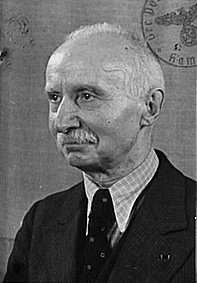Search for Names, Places and Biographies
Already layed Stumbling Stones
Suche
Fritz Weinstein * 1869
Innocentiastraße 37 (Eimsbüttel, Harvestehude)
1942 Theresienstadt
1942 weiterdeportiert nach Treblinka
further stumbling stones in Innocentiastraße 37:
Prof. Friedrich Adler, Zerline Adler, Kaethe (Käte) Pincus, Martin Pincus, Abraham Sarfaty, Franziska Sarfaty, Joseph Sarfaty, Rosa Sarfaty, Israel Abraham Sarfaty, Annette Sarfaty, Ruth Klara Sarfaty, Benjamin Sarfaty, Henriette M. Schmid, Gertrud Weinstein
Fritz Weinstein, born on 28 Jan. 1869 in Wommen, deported on 19 July 1942 to Theresienstadt, further deported to Treblinka on 21 Sept. 1942
Innocentiastrasse 37 (Harvestehude)
Fritz (Peres) Weinstein, son of Victor Weinstein (1833–1900) and Gertrud (Geldchen) Weinstein, née Rothschild (1839–1901), was born in 1869 in Wommen near Eschwege (northern Hessen). The parents had moved to the neighboring village of Nesselröden only a short time later, where they acquired an inn and ran it themselves until it was sold in 1882/83, after which they bought in that town a half-timbered house which served as their residence. Fritz Weinstein’s parents were buried in the Jewish Cemetery in Herleshausen in 1900 and 1901.
Fritz Weinstein moved to Waltershausen for his apprenticeship, married Sarah, née Cramer, and he was later able to take over the women’s and men’s clothing business (Waltershausen, Bremerstrasse 4) where he had learned his trade as the owner of the company. His wife died in 1932 and his daughter Gertrud in 1933. After massive boycotts directed by the Nazi regime, Fritz Weinstein had to file for bankruptcy for his clothing business in 1934/35. He still managed to enable his two granddaughters to emigrate to Palestine.
Deprived of his economic livelihood, Fritz Weinstein moved to Gotha in 1936, where he resided at Friedrichstrasse 19; the house owner was the Jewish porcelain manufacturer Julius Simon. In late summer 1937, Fritz Weinstein moved from Gotha to Hamburg.
On his Jewish religious tax (Kultussteuer) card file, which was on file from 1937 to 1940 with the Hamburg Jewish Community, his residential addresses were listed from 19 Sept. 1937 as Schäferkampsallee 49 with his widow Gertrud Hirschfeldt, and from 6 Aug. 1941 as Innocentiastrasse 37. The last address was a former villa that had been converted into a synagogue of the Hamburg Portuguese-Jewish Community and dedicated on 14 Mar. 1935. The building was declared a "Jews’ house” ("Judenhaus”) by the Nazi regime and was used as a collection center in preparation for the deportations.
Fritz Weinstein and Gertrud Hirschfeldt, née Samuel (born on 7 Oct. 1884 in Trebbin, Brandenburg) married in Hamburg in Sept. 1937. In Hamburg, the couple belonged to the Orthodox Synagogue Association (Synagogenverband), the largest of the three Hamburg Jewish religious associations. The Franz Hirschfeldt textile store, which had been founded in 1910 by Gertrud’s first husband, was listed for the last time in the Hamburg directory of 1938 and it was most likely closed in the course of the Nazi policy aimed at destroying the livelihood of Jewish tradesmen. The implementing regulation of the "Ordinance on the Elimination of the Jews from German Economic Life” ("Verordnung zur Ausschaltung der Juden aus dem deutschen Wirtschaftsleben”) dated 23 Nov. 1938 stipulated, "retail sales outlets, mail-order businesses, or order offices of Jews are to be dissolved and liquidated on principle.” This deprived Mr. and Mrs. Weinstein of the basis for regular income.
In the following period, Fritz and Gertrud Weinstein had to live on their savings and presumably had to sell parts of their household effects in order to be able to pay rent and living expenses. Beginning in Sept. 1939, they were obligated to buy in separate stores for Jews.
Fritz’s sister Jeanette "Nettchen” Weinstein (born on 4 July 1871 in Nesselröden) moved to join him in Hamburg in Mar. 1939, and as early as May 1939, she moved on to Kassel, residing there at Hedwigstrasse 9. From Kassel, she was deported to the Theresienstadt Ghetto on 7 Sept. 1942, where she died on 25 Feb. 1943.
Fritz and Gertrud Weinstein were deported to the Theresienstadt Ghetto on 19 July 1942, and on 21 Sept. 1942 further on to the Treblinka extermination camp, where they were murdered soon after arrival; their exact dates of death are not known.
A Stolperstein was laid for Fritz Weinstein in Waltershausen in 2014. Since 2003, a Stolperstein in Hamburg has been commemorating him and his second wife Gertrud.
Translator: Erwin Fink
Kindly supported by the Hermann Reemtsma Stiftung, Hamburg.
Stand: December 2020
© Björn Eggert
Quellen: 1; 4; 5; Staatsarchiv Hamburg (StaH) 522-1 (Jüdische Gemeinden), 992b (Kultussteuerkartei der Deutsch-Israelitischen Gemeinde Hamburg), Fritz Weinstein; Stadtarchiv Eschwege (Ausweis von Fritz Weinstein mit Passbild, ausgestellt 10.1.1939 in Hamburg); Stadtarchiv Gera (Adressbuch 1937, Angaben zum Vermieter); Arbeitskreis "Stolpersteine" im Werratalverein (Angaben Jüd. Friedhof Herleshausen, Gräber Weinstein 2.6 und 3.1); Der Südringgau, Wochenzeitung der Gemeinde Herleshausen, Stolpersteine in Nesselröden Teil 7 Familie Weinstein, 4.2.2016; Friedrich Detlev Hardegen (Hrsg.), Hingesehen – Weggeschaut, Die Novemberpogrome 1938 in Augenzeugenberichten, Stettin 2013, S. 156, 159 (Gesetze);www.tracingthepast.org (Volkszählung Mai 1939), Fritz Weinstein, Gertrud Weinstein, Jeanette Weinstein(eingesehen 4.4.2017).
Zur Nummerierung häufig genutzter Quellen siehe Link "Recherche und Quellen".


